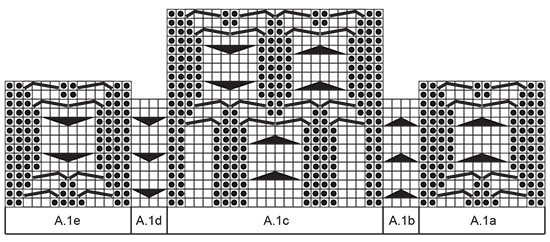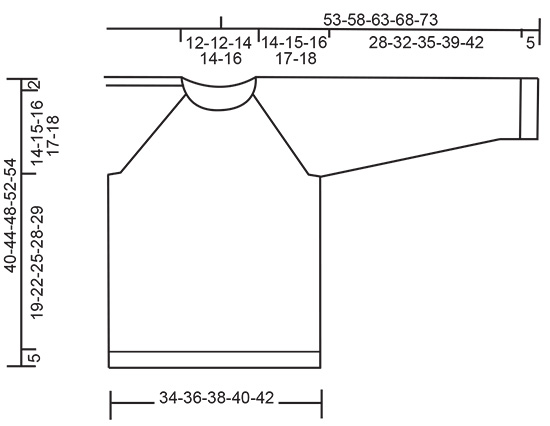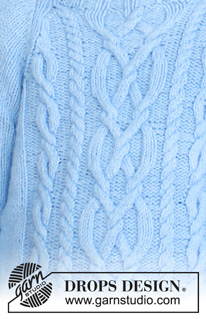Winter Clouds |
|||||||||||||||||||||||||
 |
 |
||||||||||||||||||||||||
Knitted sweater for kids with raglan and cables in DROPS Karisma or DROPS Lima. Size 5-14 years
DROPS Children 37-12 |
|||||||||||||||||||||||||
|
---------------------------------------------------------- EXPLANATION FOR THE PATTERN: ---------------------------------------------------------- PATTERN: See diagram A.1. The diagram shows the pattern seen from right side. INCREASE TIP (applies to sleeve): Increase stitches on each side of 2 stitches on the underside of sleeve. Increase by making 1 yarn over on each side of the 2 middle stitches. On next round work yarn overs twisted to avoid holes. RAGLAN: Decrease on each side of all 4 markers(= 8 decreases per round). Work until 3 stitches remain before marker and knit 2 together, knit 2 (marker is between these 2 stitches), slip 1 stitch knitwise, knit 1, pass slipped stitch over stitch worked. ---------------------------------------------------------- START THE PIECE HERE: ---------------------------------------------------------- SWEATER - SHORT OVERVIEW OF THE PIECE: Body is worked in the round on circular needle up to armhole. Work sleeves in the round on double pointed needles. Slip the parts together and work yoke in the round from here. After decrease for neck work back and forth. Work neck edge in the round on a short circular needle or double pointed needles. BODY: Cast on 158-166-174-182-190 stitches on circular needle size 3 mm = US 2,5 with Karisma or Lima. Knit 1 round, then work rib as follows: * Purl 2, knit 2 *, work from *-* over 20 stitches, knit 2, then work from *-* the rest of round (there are 4 knit stitches mid front, i.e. this round does not begin in the side). When piece measures 5 cm = 2", switch to circular needle size 4 mm = US 6. Work next round as follows: Purl 2, knit 1, 1 yarn over, knit 1, purl 2 in each of the next 2 stitches (= 4 purl stitches), knit 1, 1 yarn over, knit 1, purl 2, knit 2 in each of the next 2 stitches (= 4 knit stitches), purl 2, knit 1, 1 yarn over, knit 1, purl 2 in each of the next 2 stitches (= 4 purl stitches), knit 1, 1 yarn over, knit 2 (= mid front), 1 yarn over, knit 1, purl 2 stitches in each of the next 2 stitches (= 4 purl stitches), knit 1, 1 yarn over, knit 1, purl 2, knit 2 in each of the next 2 stitches (= 4 knit stitches), purl 2, knit 1, 1 yarn over, knit 1, purl 2 stitches in each of the next 2 stitches (= 4 purl stitches), knit 1, 1 yarn over, knit 1, purl 2. Work the rest of round as follows in the different sizes: SIZE 5/6 years: Knit 1, * knit 2 together, knit 4, knit 2 together, knit 5 *, work from *-* the rest of round. SIZE 7/8 years: * Knit 2 together, knit 5 *, work from *-* the rest of round. SIZE 9/10 years: Knit 8, * knit 2 together, knit 5 *, work from *-* the rest of round. SIZE 11/12 years: Knit 7, * knit 2 together, knit 5, knit 2 together, knit 6 *, work from *-* the rest of round. SIZE 13/14 years: Knit 6, * knit 2 together, knit 6 *, work from *-* the rest of round. ALL SIZES: There are now 160-168-176-184-192 stitches. Continue as follows: Work A.1 over the first 60 stitches (i.e. A.1a over the first 14 stitches, A.1b over the next 4 stitches, A.1c over the next 24 stitches, A.1d over the next 4 stitches and A.1e over the last 14 stitches), work in stockinette stitch over the remaining stitches on round. Count 14-16-18-20-22 stitches outwards from each side of A.1 and insert 1 marker (these marks the sides), there are 72-76-80-84-88 stitches between markers on back piece. REMEMBER THE KNITTING GAUGE! When piece measures 24-27-30-33-34 cm = 9½"-10⅝"-11¾"-13"-13 13/8", bind off 6 stitches in each side for armholes (i.e. 3 stitches on each side of each marker) = 148-156-164-172-180 stitches on needle. Put piece aside and work the sleeves. SLEEVE: Cast on 40-44-44-48-48 stitches on double pointed needles size 3 mm = US 2,5 with Karisma or Lima. Knit 1 round, continue with rib with knit 2 and purl 2 for 5 cm = 2". Insert 1 marker between the first 2 stitches = mid under sleeve). Switch to double pointed needles size 4 mm = US 6 and work in stockinette stitch. When sleeve measures 8-8-9-9-10 cm = 3⅛"-3⅛"-3½"-3½"-4", increase 1 stitch on each side of the 2 stitches under sleeve – read INCREASE TIP in explanation above. Repeat increase every 3-3½-3-3½-3 cm = 1⅛"-1¼"-1⅛"-1¼"-1⅛" a total of 7-7-9-9-11 times = 54-58-62-66-70 stitches. When piece measures 33-37-40-44-47 cm = 13"-14½"-15¾"-17¼"-18½", bind off 6 stitches under sleeve (i.e. 3 stitches on each side of marker) = 48-52-56-60-64 stitches. Put piece aside and knit another sleeve the same way. YOKE: Slip sleeves on to same circular needle as body, slip them on where armholes were bind off = 244-260-276-292-308 stitches. Insert 1 marker in all transitions between sleeves and body = 4 markers. NOTE! Begin neck decrease before all decreases for raglan are done, READ THE ENTIRE SECTION BEFORE CONTINUING! Continue with pattern A.1 and stockinette stitch as before but work 1 stitch in stockinette stitch on each side of each marker onwards. On 2nd round begin decreases for RAGLAN – see explanation above! Repeat decreases every other round 19-21-23-24-26 times in total. When piece measures approx. 35-39-43-47-49 cm = 13¾"-15¼"-17"-18½"-19¼" (adjust so that so that you are on a round with 6 knit stitches mid front in pattern), work the middle 14 stitches at the front together 2 by 2 = 7 stitches (the middle 6 stitches are knitted together 2 by 2 and the 4 stitches on each side are purled together 2 by 2). On next round, slip the middle 17 stitches at the front on 1 stitch holder for neck (= entire A.1c). Continue piece back and forth from mid front until finished measurements - AT THE SAME TIME bind off for neck at the beginning of every row in each side: 2 stitches 2 times and 1 stitch 2 times. After all decreases for raglan and bind offs for neck, there are 56-56-56-64-64 stitches on needle. NECK: Switch to double pointed needles or a short circular needle size 3 mm = US 2,5, pick up approx. 29 to 35 stitches at the front of neck (including stitches from stitch holder) = approx. 85 to 99 stitches on needle. Knit 1 round while at the same time adjusting number of stitches so that there are 8 stitches over each sleeve, 24-28-28-32-32 on the over back piece and 35-35-35-43-43 stitches over front piece (do not increase or decrease over the middle 17 stitches) = 75-79-79-91-91 stitches on round. Work rib in the round as follows: Continue the 2 stitches from the raglan line as knit 2, then purl 2, knit 2 and purl 2 over each sleeve, work stitches on back piece into purl 2/knit 2, on the front piece work the 17 stitches in the middle as follows: Purl 2, knit 3, purl 2, knit 3, purl 2, knit 3, purl 2, work the remaining stitches on each side into knit 2 / purl 2. When neck edge measures 2-2-2-2-3 cm = ¾"-¾"-¾"-¾"-1⅛", bind off with knit over knit and purl over purl. ASSEMBLY: Sew the openings under the sleeves tog. |
|||||||||||||||||||||||||
Diagram explanations |
|||||||||||||||||||||||||
|
|||||||||||||||||||||||||

|
|||||||||||||||||||||||||

|
|||||||||||||||||||||||||
|
Have you made this or any other of our designs? Tag your pictures in social media with #dropsdesign so we can see them! Do you need help with this pattern?You'll find tutorial videos, a Comments/Questions area and more by visiting the pattern on garnstudio.com. © 1982-2024 DROPS Design A/S. We reserve all rights. This document, including all its sub-sections, has copyrights. Read more about what you can do with our patterns at the bottom of each pattern on our site. |
|||||||||||||||||||||||||


































































Comments / Questions (41)
Merci, cela me parait clair
17.11.2022 - 16:30Bonjour, je fais le modèle 11 /12 ans, j'ai fait le devant et le dos, j'ai fait les manches , j'ai rabattu les 6 mailles. Je dois maintenant tout remettre sur la même aiguille circulaire et là je ne vois pas comment cela est possible car la manche est déjà sur 4 aiguilles doubles pointes puisque tricotée en rond. Y a t'il une technique précise? Merci de m'aider
17.11.2022 - 08:55DROPS Design answered:
Bonjour Mme Devauchelle, cette vidéo montre comment tricoter une manche en rond au-dessus des mailles rabattues pour l'emmanchure; les premiers tours peuvent être un peu "tricky", vous pouvez alors laisser les manches sur les doubles pointes pendant les premiers tours ou utiliser la technique du magic loop, après quelques tours, vous pourrez de nouveau tricoter en rond "normalement". Bon tricot!
17.11.2022 - 10:19Grand merci, c'est bien clair
21.10.2022 - 11:16Merci, si je comprends bien le devant mesure 100 mailles et le dos 84, et le rang du devant débute 20 mailles avant A1. Donc la première maille d'origine quand on monte le premier rang n'est pas celle du début du rang mais du début de A1. ai je bien compris? merci
21.10.2022 - 09:09DROPS Design answered:
Bonjour Mme Devauchelle, tout à fait; il faut plus de mailles pour le devant à cause des torsades et la 1ère maille des tours est la 1ère de A.1.Bon tricot!
21.10.2022 - 09:43Je n'arrive pas à comprendre l'emplacement des marqueurs (dos, devant). A1 fait 60 mailles + 20 =80= 1° marqueur Si je mets le deuxième marqueur de l'autre côté de A1 après la 20° maille, j'ai 100 mailles entre les deux marqueurs et non 84 (taille 11/12 ans). pouvez vous m'expliquer ce que je fais mal merci d'avance
20.10.2022 - 19:53DROPS Design answered:
Bonjour Mme Devauchelle, les tours commencent juste avant les torsades, pas sur le côté, autrement dit, vous devez avoir cette configuration: 20 m jersey, (début du tour), A.1 (60 m), 20 m jersey (côté), 84 m jersey. Ainsi vous avez bien vos 20+60+20+84=184 mailles (le dos se tricote en jersey, sans torsades). Bon tricot!
21.10.2022 - 08:33Bonjour, Le diagramme contient plusieurs rangs. Je fais les 12 premiers rangs en partant du bas et de droite à gauche car je tricote en rond, ensuite, je recommence au 1er rang pour obtenir ma longueur désirée. Est-ce que bien comme ça que je dois lire le diagramme? Merci beaucoup
10.10.2022 - 15:46DROPS Design answered:
Bonjour Mme Badeau, les différents diagrammes ne se tricotent pas sur le même nombre de rangs en hauteur, autrement dit, quand vous avez terminé A.1b (= 12 rangs), reprenez au 1er rang mais continuez les autres diagrammes comme avant; quand A.1a est terminé (= 14 rangs), reprenez-le au 1er rang mais continuez les autres diagrammes comme avant, et, quand A.1c est terminé, reprenez-le au 1er rang. Veillez à toujours bien avoir le bon nombre de rangs entre chaque torsade dans chaque diagramme. Bon tricot!
10.10.2022 - 16:09Bonjour, cela fait 3 fois que je démanche mon tricot car le motif du milieu (A.1c) n'est pas correct. Je tricote en rond et je lis le patron de droite à gauche. Pourriez-vous avoir une idée pourquoi? Merci
08.10.2022 - 20:40DROPS Design answered:
Bonjour Mme Badeau, il est très difficile de pouvoir vous répondre ainsi sans voir votre ouvrage, essayez de placer des marqueurs après chaque diagramme pour bien délimiter les zones et vérifier comment les tricoter - en cas de doute, apportez votre ouvrage à votre magasin ou bien envoyez-lui une photo, ce sera plus simple pour eux de vous aider à repérer l'erreur. Bon tricot!
10.10.2022 - 09:06Bonjour, Je fais le modèle u-079-bn, drops children 37-12. Le motif du diagramme A.1c ne fonctionne pas. Je tricote les 12 rangs et lorsque je recommence à partir du premier rang le motif n’est pas correct. Qu’est-ce je fais de pas correct? Merci
01.07.2022 - 20:12DROPS Design answered:
Bonjour Denise, lorsque vous tricotez les diagrammes, ils se répètent à un rythme différent, par ex. A.1a et A.1e se tricotent sur 14 rangs; A.1b et A.1d sur 12 rangs et A.1c sur 22 rangs. Autrement dit, lorsque vous avez tricoté 12 rangs, reprenez A.1b et d au début, mais continuez les autres diagrammes, lorsque vous avez tricoté 14 rangs, reprenez A.1 a et e au début, mais continuez les autres diagrammes et ainsi de suite. Bon tricot!
04.07.2022 - 07:48Andre omgang starter med vrangbord og etter 20 m 2 rett, slikat det blir 4 rett etter hverandre. Det står at det er 4 masker rett midt foran dvs ar denne omgangen ikke starter i siden (?) Blir usikker på hvor omg 3 begynner. Skal vel ikke ‘hoppe’ over 20 masker?
29.04.2022 - 17:07DROPS Design answered:
Hei Trine. Du skal ikke "hoppe" over noen masker, men når du begynner med vrangborden er det 20 masker fra midt foran. Når du er ferdig med vrangborden (5 cm) og skal strikke etter forklaringen vil vrangborden stemme overens med flettene (forklaringen etter du har byttet til rundpinne 4), og du vil da se, i den str. du strikker at flettemønstrene kommer i front. mvh DROPS Design
02.05.2022 - 12:14Skal A1c starte på omgang 1 igjen etter at en har strikket de 22 omgangene i diagrammet
13.12.2021 - 23:13DROPS Design answered:
Hei Eli Karin. Ja, det stemmer. mvh DROPS Design
14.12.2021 - 13:55